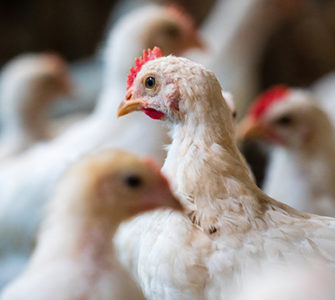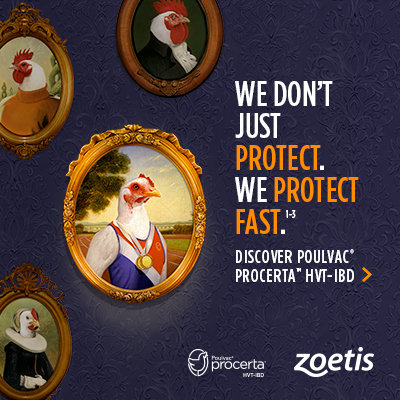AL2 variants now account for more than half of IBDV field isolates in broilers
AL2 variants now account for more than half of the infectious bursal disease virus (IBDV) field isolates in broilers, according to the results of a 5-year survey1 that has important implications when planning vaccination programs.
“The survey also demonstrated tremendous diversity among IBDV variants,” said Kalen Cookson, DVM, director of clinical research, Zoetis. “This finding underscores the need for routine bursal surveys to identify the types of IBDV circulating locally so that wise vaccine choices can be made.”
The survey was conducted from 2014 until early 2019. Zoetis investigators collected bursas from more than 300 broiler flocks in 16 states, representing birds from every major broiler-producing region of the US (east to west, north to south). The flocks were between 2 and 5 weeks of age.
There were 139 samples positive for IBDV. Using reverse transcription polymerase chain reaction and sequencing analysis, IBDVs were categorized into one of five variant categories: Delaware-E, AL2, T1, Group-6 and New-type.
AL2 variants accounted for 52% of all wild-type IBDV, up from 46% in a similar survey conducted from 2009 to 2011 (Figure 1), Cookson said.
The next most prominent IBDV variants were T1, followed by New-type, Group-6 and Delaware-E, he said.
Within the AL2 family of variants, there were four unique subtypes, but the original AL2 type still accounted for the vast majority (82%). The prevalence of New-type variants has increased substantially, while Delaware-E has declined to only 8%,3 Cookson said.
AL2 variants are genetically different from the Delaware-E variant, which was the first important variant to emerge in the 1980s, he explained.
The T1 viruses are more similar to the AL2 family of viruses. Like the AL2 and T1 variants, the catch-all New-type variants are also genetically different from the Delaware-E variants. Group-6 viruses are perhaps the most antigenically diverse group of IBDVs. Some Group-6 viruses share some similarities with Delaware-E while others are quite distinct from them, Cookson said.
 Identify IBDV types
Identify IBDV types
IBDV is a highly contagious disease, he explained. The classic type of IBDV can cause mortality of up to 20%,4 and mortality can often exceed 50% with very virulent IBDV.5 The virus destroys the bursa, leading to immunosuppression that in turn predisposes flocks to costly secondary bacterial infections, which is a big concern for flocks raised without antibiotics.
Immunosuppression is usually more severe in birds infected before 2 weeks of age and is especially a risk if birds have low maternal antibodies to IBDV. However, it’s important to note that flocks infected after 3 weeks of age can still suffer from a temporary dip in immune function, giving other diseases an opportunity to create issues.
Because the variant types of IBDV that have emerged over the years are so diverse, Cookson advises producers to routinely sample and test flocks every 1 to 2 years, depending on bird and bursa health.
“You have to know what types of IBDVs are circulating to choose appropriate vaccines,” he said. “It’s very likely AL2 variants are present — but don’t assume that a vaccine effective against Delaware-E will protect against AL2 variants.”
Studies show that both inactivated and the newer recombinant vaccines can vary widely in the protection they provide against AL2 variants as well as classical IBDV6,7,8 Cookson continued.
Start with breeders
“Start with a robust breeder vaccination program so that broiler chicks have passive immunity from maternal antibodies,” he added. Broilers can also benefit from active immunity, which can be achieved from the hatchery with immune-complexed or herpesvirus-of-turkey (HVT) recombinant IBDV vaccines.
The HVT-IBDV vaccines also protect against Marek’s disease virus, another immunosuppressive pathogen. They are widely recognized to be safe and can be administered in ovo. When broilers have IBDV maternal antibodies and receive an effective recombinant IBDV vaccine, hatchery or field vaccination with a live IBDV vaccine should be unnecessary unless there’s an unusual circumstance, such as an especially strong field challenge, Cookson said.
He noted that the evolution and diversity of IBDVs is no surprise. IBDVs are practically indestructible, and because US broilers are usually raised on built-up litter, there’s high IBDV infection pressure as well as competition among subtypes to override maternal antibodies. Antibodies to only Classic and Delaware-E antigens are not enough in the battle against today’s variants, he said.
1 Cookson K, et al. A survey of wild type IBDV isolated from broiler flocks in the United States since 2014. 2020 International Poultry Scientific Forum, Atlanta, Georgia.
2 Cookson K, et al. A review of IBD viruses isolated from US broilers from 2009-2011. 2012 Proceedings 61st Western Poultry Disease Conference, Scottsdale, Arizona.
3 Cookson K, et al. A survey of wild type IBDV isolated from broiler flocks in the United States since 2014.
4 Dey S, Pathak D, Ramamurthy N, Maity HK, Chellappa MM. Infectious bursal disease virus in chickens: prevalence, impact, and management strategies. Vet Med: Res Rep. 2019;10:85-97.
5 Ibid.
6 Cookson K, et al. Update on IBD viruses infecting broilers today and how inactivated vaccines protect against different viruses in the AL2 family. 2020 Western Poultry Disease Conference.
7 Data on file. Study Report No. B815R-US-19-B22. Zoetis, LLC. 8 Data on file. Study Report No. B815R-US-19-B80. Zoetis, LLC.
DISCOVERIES, Issue 10
Discoveries is a series of research news reports written by the editors of Poultry Health Today on behalf of the US Poultry Business of Zoetis.
BIO-00291
December 2020
Posted on December 25, 2021













